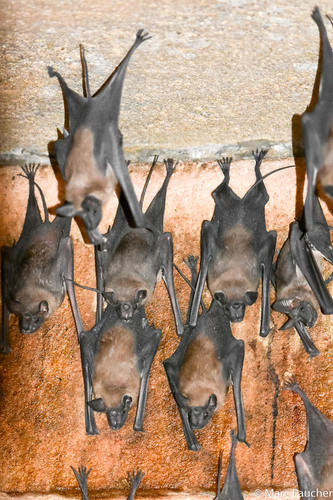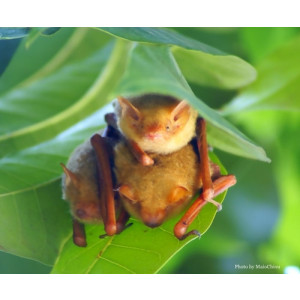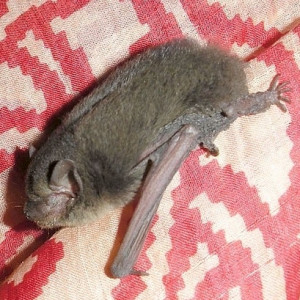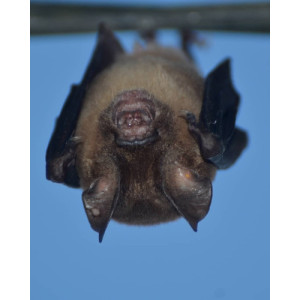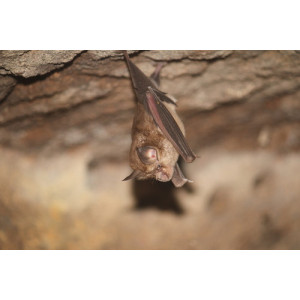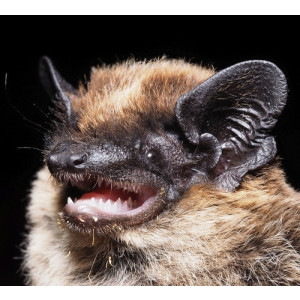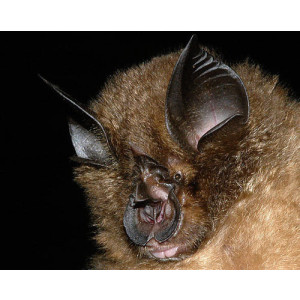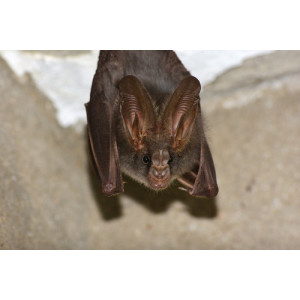Greater Mouse-tailed Bat Did you see this animal?
Scientific Name : Rhinopoma microphyllum
Family : Rhinopomatidae
Order : Chiroptera
Class : Mammalia
Phylum : Chordata
Habitat : Shrubland, Caves and Subterranean Habitats (non-aquatic), Desert
Description : The Greater Mouse-tailed Bat is similar in appearance to the Lesser Mouse-tailed Bat, but is larger and has a longer tail relative to its body size.
They have a wingspan of around 40cm and weigh between 15-22 grams.
Their fur is generally brownish-gray, with paler undersides and darker fur around their face and ears.
The Greater Mouse-tailed Bat is nocturnal and feeds mainly on insects such as moths, beetles, and flies.
They use echolocation to locate prey and navigate their surroundings.
These bats are social and typically roost in groups of up to 50 individuals in caves, rock crevices, and buildings
Greater Mouse-tailed Bats are found in a range of habitats including deserts, dry savannas, and rocky areas.
They are most commonly found in arid regions, and are well adapted to the harsh conditions of these environments.
Reproduction:
Females give birth to a single offspring each year.
They typically mate in the fall and the young are born in the spring.
The young are weaned after around 6-8 weeks and become independent after a few months.
The long, slender tail of the Greater Mouse-tailed Bat helps it to maneuver through narrow rock crevices and other tight spaces.
Their wings are also adapted to their arid habitat, with a thick, leathery texture that helps them retain moisture and cope with dry conditions.
They are able to lower their metabolic rate and enter a state of torpor during periods of food scarcity or extreme heat, allowing them to conserve energy and water.
The Greater Mouse-tailed Bat is not currently considered threatened, but may be impacted by disturbances from human activities such as cave exploration and tourism.
They may also be impacted by pesticide use, as they are insectivorous and may consume insects that have been exposed to pesticides.
Climate change and habitat loss may also pose future threats to this species.
They have a wingspan of around 40cm and weigh between 15-22 grams.
Their fur is generally brownish-gray, with paler undersides and darker fur around their face and ears.
The Greater Mouse-tailed Bat is nocturnal and feeds mainly on insects such as moths, beetles, and flies.
They use echolocation to locate prey and navigate their surroundings.
These bats are social and typically roost in groups of up to 50 individuals in caves, rock crevices, and buildings
Greater Mouse-tailed Bats are found in a range of habitats including deserts, dry savannas, and rocky areas.
They are most commonly found in arid regions, and are well adapted to the harsh conditions of these environments.
Reproduction:
Females give birth to a single offspring each year.
They typically mate in the fall and the young are born in the spring.
The young are weaned after around 6-8 weeks and become independent after a few months.
The long, slender tail of the Greater Mouse-tailed Bat helps it to maneuver through narrow rock crevices and other tight spaces.
Their wings are also adapted to their arid habitat, with a thick, leathery texture that helps them retain moisture and cope with dry conditions.
They are able to lower their metabolic rate and enter a state of torpor during periods of food scarcity or extreme heat, allowing them to conserve energy and water.
The Greater Mouse-tailed Bat is not currently considered threatened, but may be impacted by disturbances from human activities such as cave exploration and tourism.
They may also be impacted by pesticide use, as they are insectivorous and may consume insects that have been exposed to pesticides.
Climate change and habitat loss may also pose future threats to this species.
Distribution in Bangladesh
References:
description written by:Asad U. Tanvir,Department of Zoology,Jagannath University,Dhaka; reviewed by:Muntasir Akash,Department of Zoology,University of Dhaka;Taxonomic Checklist:Red List of Bangladesh Volume 2: Mammals, 2015, IUCN; information sources:sarkive.com; photo credit:A. Müller (www.inaturalist.org/people/A. Müller ), photo copyright: iNaturalist.more information please contact with us.
description written by:Asad U. Tanvir,Department of Zoology,Jagannath University,Dhaka; reviewed by:Muntasir Akash,Department of Zoology,University of Dhaka;Taxonomic Checklist:Red List of Bangladesh Volume 2: Mammals, 2015, IUCN; information sources:sarkive.com; photo credit:A. Müller (www.inaturalist.org/people/A. Müller ), photo copyright: iNaturalist.more information please contact with us.
